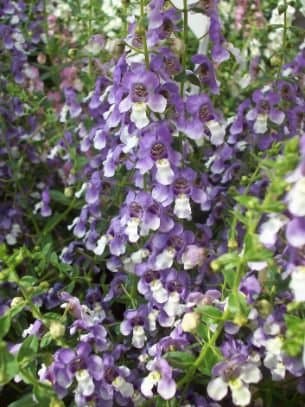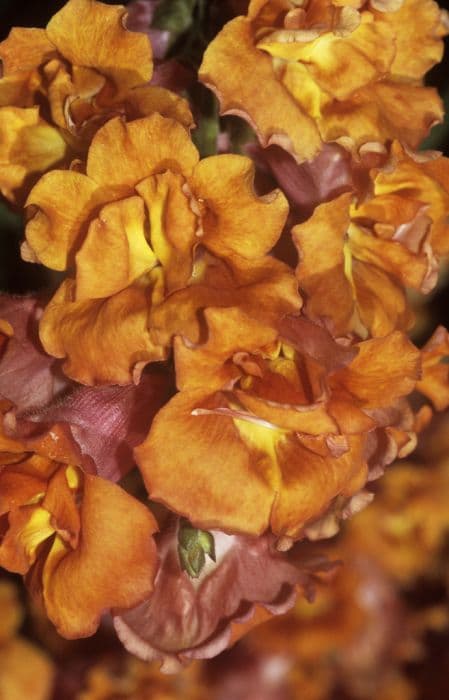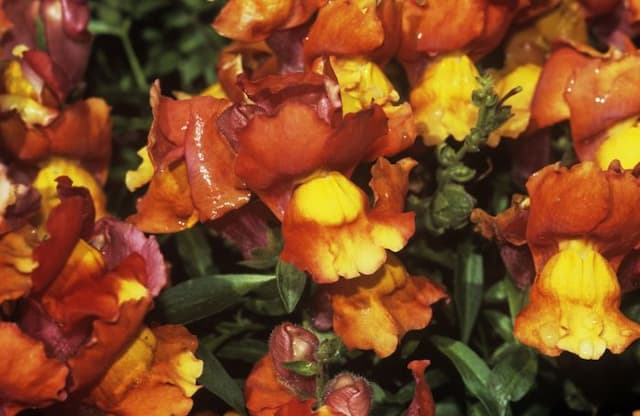Turtlehead Chelone obliqua

ABOUT
The plant commonly known as turtlehead, due to its unique flower shape resembling a turtle's beak, is a perennial with a distinct and attractive appearance. Its flowers are a notable feature, arranged in dense clusters at the top of the stems. Each blossom has a hooded, two-lipped shape, with the upper lip arching over the lower one. The color palette of the flowers includes shades of pink, white, and sometimes purple, providing a soft and inviting display. The foliage of turtlehead is another key aspect of its appearance, comprised of lush, deep green leaves that are lance-shaped, with a finely toothed edge creating a serrated look. The leaves grow oppositely along the stems, offering a robust and full-bodied presence in the landscape. The stems themselves are upright and sturdy, supporting the substantial flower heads without bending or drooping, maintaining a neat and upright posture that's visually appealing in garden settings. Turtlehead blooms in the late summer to early fall, during which time it becomes a hub of activity for pollinators, particularly bees, who are attracted to the shape and structure of the flowers. The plant's overall structure and leafy backdrop make it an excellent choice for adding texture and layers to a garden that enjoys subtle color variations and intricate flower forms.
About this plant
 Names
NamesFamily
Plantaginaceae
Synonyms
Rose Turtlehead, Pink Turtlehead, Red Turtlehead, Twistleaf Turtlehead
Common names
Chelone glabra var. obliqua, Chelone montana, Pentstemon obliquus, Chelone obliqua var. speciosa.
 Toxicity
ToxicityTo humans
Turtlehead is not commonly known to be poisonous to humans. There is little information available that suggests Chelone obliqua has toxic properties that would cause harm if ingested or handled. However, as with any plant, individual allergies or reactions could occur, so it is generally advisable to avoid eating or handling plants unless they are known to be safe.
To pets
Turtlehead is also not known to be toxic to pets. There is limited evidence of the Chelone obliqua causing poisoning in animals. As with the information available on its effects on humans, this plant does not typically present a risk of toxicity to pets. Nevertheless, it is always good practice to prevent pets from ingesting plants not intended for consumption, as they might cause gastrointestinal upset or other issues due to the non-digestible fibers or individual sensitivity.
 Characteristics
CharacteristicsLife cycle
Perennials
Foliage type
Deciduous
Color of leaves
Green
Flower color
Pink
Height
2-4 feet (0.6-1.2 meters)
Spread
2-3 feet (0.6-0.9 meters)
Plant type
Herb
Hardiness zones
3-8
Native area
North America
Benefits
 General Benefits
General Benefits- Attracts Pollinators: Chelone obliqua, commonly known as turtlehead, is known for attracting bees and butterflies, which are essential for the pollination of many plants.
- Aesthetic Appeal: With its unique flower shape resembling a turtle's head and attractive foliage, it adds beauty and interest to gardens.
- Wildlife Habitat: It provides shelter and food for various wildlife, including caterpillars of certain butterfly species that feed on its leaves.
- Erosion Control: The plant has a clumping habit with a sturdy root system that helps stabilize soil and prevent erosion.
- Low Maintenance: Turtlehead is considered a low maintenance plant, which is ideal for gardeners seeking minimal care plants.
- Drought Tolerant: Once established, it can tolerate periods of drought, making it suitable for gardens in areas with varying rainfall.
- Shade Tolerance: It can thrive in shaded areas where other plants may struggle to grow, making it a versatile choice for garden design.
 Medical Properties
Medical PropertiesThis plant is not used for medical purposes.
 Air-purifying Qualities
Air-purifying QualitiesThis plant is not specifically known for air purifying qualities.
 Other Uses
Other Uses- Chelone obliqua, commonly known as turtlehead, has been used as a natural fabric dye, yielding subtle shades of green and brown depending on the mordant used.
- Its sturdy stems can be incorporated into floral arrangements, providing a unique texture and form that complements softer flowers.
- The fibrous roots can be useful in preventing soil erosion, making turtlehead a beneficial plant for riverbanks and areas prone to washouts.
- Turtlehead's dense foliage offers a natural habitat for beneficial insects, contributing to the biodiversity of garden ecosystems.
- The crushed leaves of turtlehead can be rubbed on items to naturally repel herbivorous animals, such as deer or rabbits, from gardens.
- As an educational tool, turtlehead can be used in school gardens to teach children about coevolution with its specialized pollinators, like bumblebees.
- Enthusiasts of ornamental fish ponds sometimes plant turtlehead around the perimeter for its attractive flowers and to provide shade for aquatic life.
- With its tendency to grow in clumps, turtlehead can be utilized to create natural-looking borders or divisions within garden spaces.
- The flowers can be dried and used in potpourri mixes, providing a delicate, natural fragrance to indoor environments.
- Turtlehead can be planted to create a themed garden area, such as a 'storybook' garden, due to its unique flower shape reminiscent of open-mouthed turtles.
Interesting Facts
 Feng Shui
Feng ShuiThe Turtlehead is not used in Feng Shui practice.
 Zodiac Sign Compitability
Zodiac Sign CompitabilityThe Turtlehead is not used in astrology practice.
 Plant Symbolism
Plant Symbolism- Overcoming Adversity: Chelone obliqua, commonly known as turtlehead, due to the unique shape of its flowers resembling a turtle's beak, symbolizes resilience and the ability to thrive despite difficulties, much like how a turtle's shell provides protection against challenges.
- Protection: The turtlehead flower, by virtue of its name and appearance, also symbolizes protection, suggesting that it can act as a shield or form of guardianship in various cultural contexts.
- Persistence: This plant's capability to grow in harsh conditions conveys the idea of persistence, encouraging determination to persevere in face of adversity.
- Longevity: Turtlehead also inherently represents longevity, drawing parallels to the long lifespan of many turtle species and symbolizing a wish for a long life.
 Water
WaterWater turtlehead plants regularly to keep the soil uniformly moist, especially in hot and dry weather conditions, usually once a week with about 1 to 1.5 gallons of water. During the growing season, increase frequency to twice a week if there's a lack of rainfall. Cut back water in the fall as the plant prepares for dormancy, especially after the first frost. In winter, reduce watering further but do not let the soil dry out completely. It's critical not to over-water, as turtleheads can suffer from root rot in waterlogged soil.
 Light
LightTurtlehead plants thrive in partial shade but can tolerate full sun in cooler climates. The best spot for a turtlehead plant is where it receives morning sunlight and is shaded during the hottest part of the day. Avoid deep shade as it can lead to leggy growth and fewer flowers.
 Temperature
TemperatureTurtlehead plants prefer temperatures ranging between 50°F and 70°F for optimal growth. They can survive minimum temperatures down to about 20°F but should be protected from harsh frosts. Summer heat above 85°F can be stressful for the plant, so providing some afternoon shade during the hottest months is beneficial.
 Pruning
PruningPrune turtlehead plants in late winter or early spring to remove any dead or damaged stems and promote healthy, bushy growth. Deadheading spent flowers can encourage a second bloom. Generally, an annual pruning is sufficient, with the best time being just before new growth begins in spring.
 Cleaning
CleaningAs needed
 Soil
SoilTurtlehead (Chelone obliqua) thrives best in a rich, moist soil mix that retains water well without becoming waterlogged. Ideal pH levels for Turtlehead range from 5.8 to 6.8, slightly acidic to neutral. A mix of loamy garden soil, peat moss, and perlite or sand to improve drainage creates a suitable environment for this plant.
 Repotting
RepottingTurtlehead plants typically do not require frequent repotting and can be left undisturbed for several years. They should be repotted when they outgrow their current container or when the soil structure begins to break down, which is usually every 2 to 3 years.
 Humidity & Misting
Humidity & MistingTurtlehead prefers a humid environment, thriving best in humidity levels above 70%. This high humidity helps replicate its natural setting, particularly if the plant is grown indoors. However, it is also quite adaptable to outdoor conditions where humidity can vary.
 Suitable locations
Suitable locationsIndoor
Keep Turtlehead in moist soil with bright, indirect light.
Outdoor
Plant Turtlehead in partial shade and keep the soil moist.
Hardiness zone
3-8 USDA
 Life cycle
Life cycleChelone obliqua, commonly known as turtlehead, begins its life cycle as a seed, which upon finding suitable moist and well-drained soil, germinates in late spring. The seedlings emerge and the plant enters its vegetative stage, growing stems and leaves in a rosette pattern. Throughout the summer, turtlehead continues to grow and then produces distinctive flowers that are shaped like turtle heads, typically blooming from late summer to early fall. After pollination, largely by bees attracted to the nectar, the flowers develop into seed capsules containing numerous small seeds. As winter approaches, the above-ground parts of the plant die back and it enters a period of dormancy, with the roots surviving underground. In the following spring, Chelone obliqua re-emerges from the rootstock to begin the cycle again.
 Propogation
PropogationPropogation time
Spring-early summer
Chelone obliqua, commonly known as turtlehead, is most effectively propagated by division. The best time for this method is in the early spring as new growth begins or in the fall after the flowering period. To propagate by division, carefully dig up the plant and gently separate it into smaller sections, ensuring that each section has a good amount of roots attached. Replant these divisions at the same depth they were growing at previously, spacing them about 18 inches to 2 feet apart to allow for growth. Water the new divisions thoroughly to establish them. This method allows for rapid increase of the plant and helps to maintain the health and vigor of the turtlehead by reducing overcrowding.








